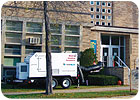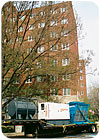
Hurricane Rita further complicated Temp-Air’s mission to dry
the five-story Rault Resources Professional Building. It had to turn to four
Model THPAC-30 air conditioners and 30 Model TD-200 dehumidifiers.
So what do you do when you have to take a building’s a/c system offline in order to make repairs? Or worse yet, what do you do when a system breaks down, and you’re going to have to wait a few days for a part? One answer is portable, or temporary, cooling.
These days, a number of portable cooling equipment distributors and manufacturers can get the right equipment to just about any corner of the United States very quickly. Whether it’s a huge chiller or a small room unit that’s needed, these companies will help you and your customers keep cool.
In short, portable air conditioners, whether purchased or rented, are an ideal way to cool people, places, equipment, and processes in almost any situation. For example, they can provide temporary air conditioning during a cooling tower repair or replacement. Many companies keep units on hand all year-round to protect their computers during an air conditioning repair, or when the overall system is insufficient. There’s almost no limit to the applications.
HOSPITAL EMERGENCY
For instance, when a 360,000-Btu chiller at a Kentucky hospital malfunctioned in the spring of this year, the hospital required immediate resolution. The failed unit had provided chilled water to support air conditioning within one of the hospital’s key isolation units, which houses patients needing critical, around-the-clock care. When the unit’s permanent chiller failed, the hospital called Aggreko to provide a temporary replacement chiller - and it needed the stand-in fast.When the call came in after-hours on a Friday, Aggreko, which provides a wide range of temporary power, heating, and cooling solutions around the world, immediately began assembling the chiller setup at its Sharonville depot outside Cincinnati.
The team worked all night to load a 720,000-Btu temporary chiller unit to provide chilled water, a 125-kilowatt (kW) generator, a 560-gallon fuel tank, and all ancillary equipment on a dropdeck trailer for overnight transport down to northern Kentucky.
Because of the distance involved, the Aggreko assembly team knew they’d need to plan for every contingency.
By 8 a.m. Saturday, the equipment was just minutes from the hospital. The installation team mobilized, and by the time they arrived at the hospital, the trailer was waiting for them.
The installers included Aggreko technicians and local technicians from the Benner Co., a specialized mechanical contractor from Cincinnati with a local presence in the area.

Sometimes the call is to supply needed temporary heat. Shown operating at a school is a mobile heating unit from Temp-Air.
The biggest challenge for the installation team was the location of the service water connection point for the cooling system’s air handler. While most facilities have a ground-level connection point for chiller water, the hospital’s was located on its roof - nine stories above the mobile chiller unit.
The technicians had to haul masses of heavy 2-inch hose in 25-foot sections up the hospital’s elevator, then connect and lower it down to the chiller rig parked next to the building. The hose was then run back to the trailer and water pumped continually up the side of the building.
Despite the labor involved, by Saturday afternoon and after some tweaking of flow rates, the temporary chiller was up and running and the isolation unit’s air conditioning was back in action. From the first call to startup, the entire operation took less than 24 hours.
The temporary setup performed per design, operating nonstop for nearly a month, while the hospital replaced its faulty chiller. Aggreko handled refueling every four days, keeping the a/c on in the hospital without interruption.
“Rapid response is an everyday part of our business,” said Shively. “Temporary cooling and heating requirements are often something that come up unexpectedly, so we operate 24/7, and we put as much effort into planning and maintenance as we do operations.
“Knowing what equipment we’d need, anticipating the unique logistical challenges of this hospital, and partnering with a local contractor - these are the kinds of measures required to meet the needs of a client and time frame like this. They weren’t about to let down their patients, and we weren’t about to let down our client.”

After
the devastating effects that Hurricane Katrina had on New Orleans, Storm
Services Inc. called upon Temp-Air to dry the five-story Rault Resources
Professional Building, which is located in the flood zone.
AFTER THE HURRICANE
After the devastating effects that Hurricane Katrina had on New Orleans, Storm Services Inc. called upon Temp-Air to dry the five-story Rault Resources Professional Building, which is located in the flood zone. The law and accounting firms that occupy the building had a lot of office equipment and documents that needed to be dried out.There was extensive damage on all five floors. Each floor was heavily partitioned so there were few common areas to place equipment or install ductwork. Multiple models of Temp-Air equipment was required to dry out and dehumidify all five levels of the building due to the irregular floor plan.
In this case, the portable air conditioners were placed around the perimeter of the facility and ductwork was set in place. Portable generators provided the power for the equipment. Portable TD-200 dehumidifiers were positioned on each floor near the office areas where they could be the most effective. Floor fans were strategically placed throughout the facility to move the dried air into areas that were difficult to penetrate.
In the long run, once the surfaces on all five floors were dry, Temp-Air was able to maintain cooler temperatures throughout the building.
But then came Hurricane Rita, which forced another mandatory evacuation of New Orleans. In this case, Hurricane Rita further complicated Temp-Air’s mission. It had to turn to four Model THPAC-30 air conditioners, 30 Model TD-200 dehumidifiers, 32 36-inch fans, two 125-kW generators, as well as two 600-A I-Line panels and electrical distribution cables to do the job.

Aggreko worked all night to load a 720,000-Btu temporary
chiller unit to provide chilled water, a 125-kilowatt (kW) generator, a
560-gallon fuel tank, and all ancillary equipment on a dropdeck trailer for
overnight transport down to northern Kentucky.
SPOT COOLING FROM THE CEILING
Data centers are always vulnerable to heat, a risk that’s exacerbated in the summer. Servers jammed into a small space start cooking quickly. By supplementing the existing air conditioning, it’s possible to cool hot spots in a cost-effective manner.One of the newest spot cooling innovations being used in data centers is a ceiling unit that can be installed quickly and permanently. DP Air in Phoenix, which designs and maintains high-technology data centers, has already turned to this technology for several customers.
Kevin McSpadden, regional manager at DP Air, describes how a freight company benefits from this solution.
“The original building air conditioning was designed with a certain load cfm for certain square footage,” said McSpadden. “The freight company had a little test lab - an IDF closet - that could no longer maintain temperature. It wasn’t cost-effective to go in and put a large system in and redo it. Ducting, rebalancing - these weren’t a solution.”
The test lab had a return-air plenum above the ceiling, which allowed McSpadden’s team to discharge the condenser air into the plenum. In this case, McSpadden turned to MovinCool’s CM12.
“It’s out of sight. It doesn’t use any floor space,” said McSpadden. “It operates off its own stat and only runs as required, so it’s a very good application.”
The ceiling device brought additional pluses as well, according to McSpadden.
“It runs on 110 volt, so the electrical installation costs were pretty low. You can run off a 110-volt, 20-amp circuit, which is easy to get in a building. And it’s not a split system, so you don’t have to penetrate the roof or go to the perimeter of the building and put a condenser outside. And there’s no core drilling.”
It’s an easy solution for building owners or managers to approve, according to McSpadden. “The capital expenditure is very, very small,” he said. “For installation, you can do a quick one-liner or draw and submit to the building owner or the building facility people. It’s not a very detailed or intricate design. It’s one supply duct in, one return duct out.
“There are four anchors. You can move it to another site if you want to. So there’s very little infrastructure impact.
“When all is said and done, the CM12 is cost-effective, doesn’t use any floor space, and has very little impact to the building,” said McSpadden.
Visit www.aggreko.com for more information on Aggreko, www.temp-air.com for information on Temp-Air, and www.movincool.com, for more information on MovinCool.
Sidebar: Tips for Choosing
Wade Sorenson, product manager for Topaz Portable Air Conditioners, provides the following questions to consider when determining a customer’s temporary cooling needs:• What power is available (110 volt, 230 volt, etc.)?
• How much floor space can be given up for a temporary unit?
• Does the unit need to sit outside and duct into the space?
• What temperature/relative humidity range is needed?
• What kind of heat load is in the room that needs to be cooled (computers, people, candy, etc.)?
Meanwhile, when it comes time to look for a provider of portable heating or cooling, the rental company/manufacturer should be a total solutions organization, said Sorenson.
“They should provide a recommended size for equipment, based on the information they gather from you, including: size of area, insulation, temperatures needed, and heat gain, etc.,” said Sorenson. “They should help determine where the equipment should be placed and offer installation options. Once installed, the provider should show the customer operation instructions and how to perform routine maintenance. They should provide a service number, including an after-hours service number, in case the equipment fails outside of regular business hours or on a weekend.”
Whether a customer should rent or purchase, Sorenson said the customer should take certain things into consideration, including tax implications, budgets, and maintenance costs.
“If you own it, you are responsible to fix it,” he said. “ If you rent, the rental provider should take maintenance responsibility based on normal wear and tear,” he said.
There’s also the “urgency factor.”
“When renting, federal, state, and local governments do not have to put the job out for bids,” he said. “When purchasing, a bid process may delay how soon they will be able to get the unit. This could cause problems, especially in emergency situations.”
Finally, how long is it needed? It’s best to know, he said.
The best thing to do to plan for a cooling emergency is to meet with a solutions organization and get an emergency plan established, said Sorenson. This means getting phone numbers (cell phone, office, and home) and back up phone numbers; establishing emergency pricing ahead of time (“This will save money.”); and establishing a time frame that the cooling is needed.
“Make sure when meeting with a solutions organization they understand what you consider an emergency response time,” he said, adding, “Make sure to pass this information to all persons responsible so that everyone knows what to do if an emergency happens.”
His last suggestion: “Don’t be afraid to ask questions.”
Publication date:07/09/2007

Report Abusive Comment